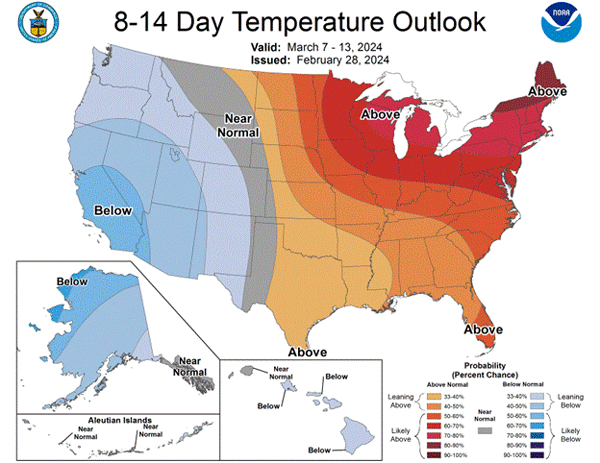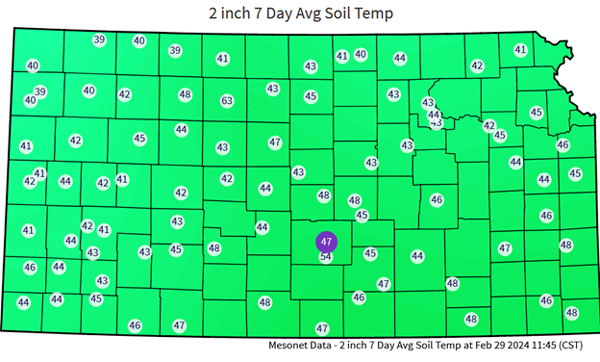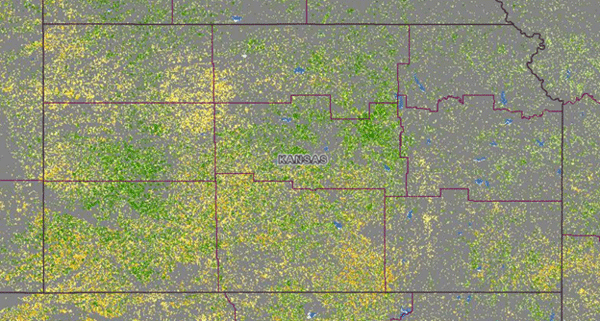Since late January, most of Kansas has experienced much warmer-than-average air temperatures for this time of the year. During the first 20 days of February, the state ran an average temperature of 41°F, an impressive 8°F above normal, ranking 8th for warmest February on record until February 21. The current 8 to 14-day outlook favors above-normal temperatures to continue into mid-March (Figure 1). The effects of these warmer-than-average temperatures on the wheat crop are concerning producers and crop consultants.

Figure 1. The Climate Prediction Center's 8 to 14-day temperature outlook as of February 28, 2024.
How warm have soil temperatures been?
The physiology of wheat vernalization and cold hardiness suggests that soil temperatures at the crown level rather than air temperatures should be the primary driver of increased or decreased cold hardiness during the winter. Soil temperatures will be influenced by tillage practice, the amount and type of residue on the soil surface, position on the landscape, and soil moisture. Soils with a thick residue layer on the surface often have lower temperatures than bare soils, as the residue blocks direct exposure to sunlight and reduces soil evaporation, generally conserving more moisture. Moist soils require more energy to cause any change in temperature than dry soils; thus, any increase or decrease in temperature occurs more slowly than in dry soils. As a result, moist soils with heavy residue will heat more slowly than dry bare soils.
Soil temperatures at the 2-inch depth ranged from around 39°F in the northwest portion of the state, to as high as 48°F in the southern portions of the state (Figure 2). The warmest soil temperatures were along the Oklahoma border in south-central counties.

Figure 2. Weekly 2-inch average soil temperatures across Kansas during the February 22-29, 2024 period. Data from the Kansas Mesonet at mesonet.ksu.edu/agriculture/soiltemp.
Daily soil temperature variations varied with the amount of solar input and remaining grass cover. Some locations have briefly approached/reached the 58-61°F mark in recent afternoons (Figure 3). With temperatures running 15-20°F above normal, the soil temperatures are greatly reflecting these conditions.

Figure 3. Maximum soil temperature at the 2-inch depth during the February 22-29, 2024 period. Data from the Kansas Mesonet at mesonet.ksu.edu/agriculture/soiltemp.
Understanding the vernalization process in winter wheat
Winter hardiness or cold tolerance is a physiological process triggered by gradually cooling temperatures in the fall. During the process of cold acclimation, there is a reduction in moisture content in the cells of the crown, which slows growth processes and the accumulation of soluble carbohydrates, all of which protect the cell membranes from freeze damage.
The process of cold acclimation within a sufficiently developed wheat seedling begins when soil temperatures at crown depth fall below 49 degrees F. Below this threshold, there is an inverse relationship of cold acclimation as affected by crown temperatures; in other words, wheat plants will acclimate twice as fast when crown temperatures are 32°F as compared to 40°F. Photoperiod also plays a role in cold hardening, with shorter days and longer nights helping initiate the process. With good and timely stand establishment for most of Kansas, the fall conditions experienced during 2023 were favorable for winterhardiness development of the 2023-24 wheat crop. Winter survival depends on the crown remaining alive; the substances that produce cold acclimation are most needed within the crown.
It takes about 4 to 6 weeks of soil temperatures below 50 degrees at the depth of the crown for winter wheat to fully cold harden. The colder the soil at the depth of the crown, the more quickly the plants will develop winter hardiness.
Temperature fluctuations during the winter and its effects on wheat cold hardiness
Cold hardiness is not a static state. After the cold hardening process begins in the fall, wheat plants can rapidly unharden when soil temperatures at the depth of the crown get above 49 degrees. But the plants will re-harden as crown temperatures cool below 49 degrees again. By the time winter begins, winter wheat will normally have reached its maximum level of cold hardiness. Wheat in Kansas normally has its maximum level of winter hardiness from mid-December to mid-January unless there are high temperatures during that period.
Once winter wheat has reached full cold hardiness, it will remain cold hardy as long as crown temperatures remain below about 32 degrees – assuming the plants had a good supply of energy going into the winter.
If soil temperatures at the crown depth rise to 50 degrees or more for a prolonged period, there will be a gradual loss of cold hardiness, even in the middle of winter. The warmer the crown temperature during the winter, the more quickly the plants will start losing their maximum level of cold hardiness. This is the situation being experienced during the 2023-24 wheat season since the many weeks of warm temperatures during early February have started to green up the crop ahead of the long-term average (Figure 4). Winter wheat can re-harden during the winter if it loses its full level of winterhardiness, but will not regain its maximum level of winter hardiness.
As soil temperatures at the crown level rise to 50 degrees or more, usually in late winter or spring, winter wheat will gradually lose its winter hardiness entirely. Photoperiod also plays a role in this process. When the leaves switch from prostrate to upright, the plants will completely de-harden.

Figure 4. Difference from average Normalized Difference Vegetative Index (NDVI) for the state of Kansas during the February 12-26, 2024 period as compared to the long-term average. Source: Kansas Applied Remote Sensing (KARS), available at: https://greenreport-kars.ku.edu/.
Possible consequences to the wheat crop
The effect of the high soil temperatures during February on the wheat crop will depend on several factors, particularly on temperatures during early March.
Where temperatures were consistently close to 50°F and with little fluctuation during the recent period, such as in many areas throughout the southeast quarter of the state, the high temperatures should cause a gradual loss of cold hardiness. The warmer the crown temperature got during this recent period, the more quickly the plants will start losing their maximum level of cold hardiness.
The forecast indicates much above normal temperatures are likely to continue into mid-March. Winter wheat can re-harden to some extent during the winter, even if it loses its full level of winter hardiness but will not regain its maximum level of winter hardiness. Thus, in the regions where soil temperatures have been warmest, the crop may be less tolerant to low temperatures for the remainder of this winter, becoming more susceptible to freeze injury if temperatures decrease to single digits in the near future. Another potential consequence of warm winter temperatures is an overall accelerated crop development during the spring, leading to the early heading of the wheat crop. A primary potential consequence of an early heading is to position heading dates within a window when freeze occurrence in the spring is more likely. If a hard freeze (28-32°F) occurs during anthesis, the consequences can be very damaging to the crop’s yield potential. However, a positive note in earlier heading is that grain filling also tends to occur earlier in the year, when hot temperatures are less likely. Cooler temperatures during grain filling can relate to increased grain yields as long as damaging frosts are avoided.
Romulo Lollato, Wheat and Forages Specialist
lollato@ksu.edu
Chip Redmond, Weather Data Library
christopherredmond@ksu.edu
Tags: wheat warm temperatures green-up